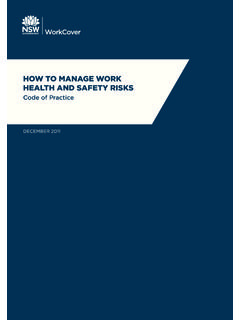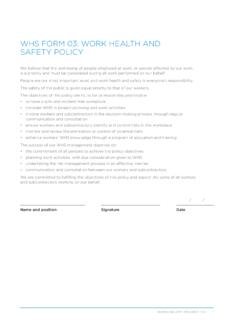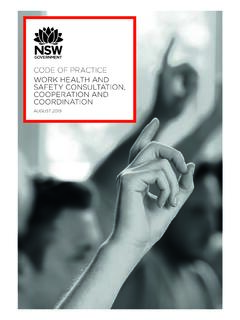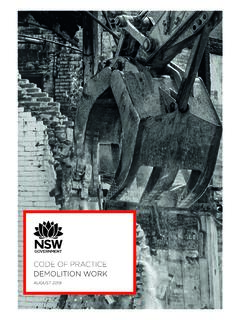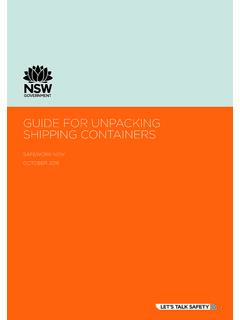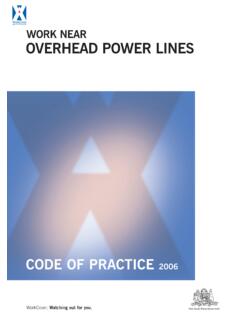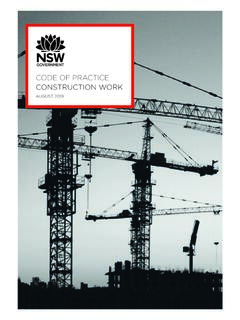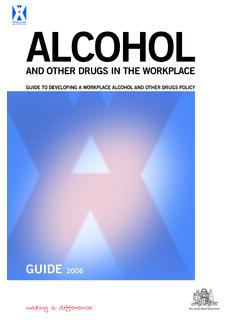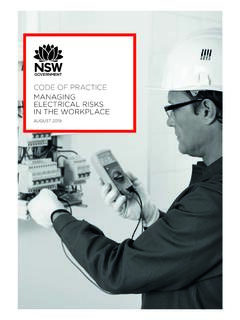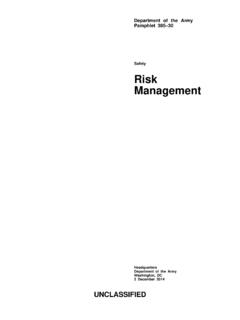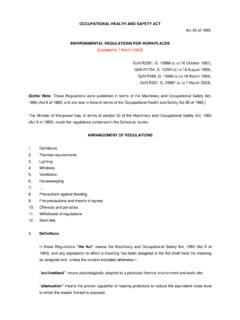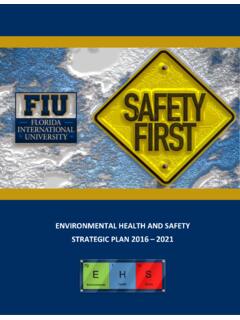Transcription of CODE OF PRACTICE - SafeWork NSW
1 code OF PRACTICESAFE DESIGN OF STRUCTURESAUGUST 2019 NSW note: This code is based on a national model code of PRACTICE developed by Safe Work Australia under the harmonisation of national work health and safety legislation and has been approved under section 274 of the NSW Work Health and Safety Act 2011. Notice of that approval was published in the NSW Government Gazette referring to this code of PRACTICE as Safe design of structures (page 2695) on Friday 18 July 2014. This code of PRACTICE commenced on Friday 18 July amendments under section 274 of the NSW Work Health and Safety Act 2011 have been published and commenced as detailed in the list of amendments contained in this for the NSW Government logo, this copyright work is licensed under a Creative Commons Attribution-Non-Commercial Australia view a copy of this licence, visit are free to copy, communicate and adapt the work for non-commercial purposes, as long as you attribute the work to SafeWork NSW and abide by the other licence design of structures code of PRACTICE Page 3 of 41 Contents Foreword.
2 4 1. Introduction .. 5 What is safe design? .. 5 Who has health and safety duties in relation to the design of structures? .. 6 What is reasonably practicable in relation to the designer s duty? .. 8 What is involved in managing risks associated with the design of structures? .. 9 2. Key elements of safe design .. 11 Consider the lifecycle .. 11 Knowledge and capability .. 11 Consultation, cooperation and coordination .. 12 Information transfer .. 13 3. Integrating design and risk management .. 16 Pre -design phase .. 17 Conceptual and schematic design phase .. 18 Design development phase .. 20 Reviewing control 23 4. Design considerations .. 24 Design for safe construction .. 24 Design to facilitate safe use .. 24 Design for safe maintenance.
3 25 Modification .. 25 Demolition and 26 Appendix A Glossary .. 27 Appendix B Roles and responsibilities .. 29 Appendix C Safety in design checklist .. 34 Appendix D Case studies .. 37 Example 1 .. 37 Example 2 .. 37 Example 3 .. 37 Example 4 .. 38 Example 5 .. 38 Example 6 .. 39 Amendments .. 40 Safe design of structures code of PRACTICE Page 4 of 41 Foreword This code of PRACTICE on how to meet the requirements for safe design of structures is an approved code of PRACTICE under section 274 of the Work Health and Safety Act (the WHS Act). An approved code of PRACTICE provides practical guidance on how to achieve the standards of work health and safety required under the WHS Act and the Work Health and Safety Regulation (the WHS Regulation) and effective ways to identify and manage risks.
4 A code of PRACTICE can assist anyone who has a duty of care in the circumstances described in the code of PRACTICE . Following an approved code of PRACTICE will assist the duty holder to achieve compliance with the health and safety duties in the WHS Act and WHS Regulation, in relation to the subject matter of the code of PRACTICE . Like regulations, codes of PRACTICE deal with particular issues and may not cover all relevant hazards or risks. The health and safety duties require duty holders to consider all risks associated with work, not only those for which regulations and codes of PRACTICE exist. Codes of PRACTICE are admissible in court proceedings under the WHS Act and WHS Regulation. Courts may regard a code of PRACTICE as evidence of what is known about a hazard, risk, risk assessment or risk control and may rely on the code in determining what is reasonably practicable in the circumstances to which the code of PRACTICE relates.
5 For further information see the Interpretive Guideline: The meaning of reasonably practicable . Compliance with the WHS Act and WHS Regulation may be achieved by following another method if it provides an equivalent or higher standard of work health and safety than the code . An inspector may refer to an approved code of PRACTICE when issuing an improvement or prohibition notice. Scope and application This code provides practical guidance to persons conducting a business or undertaking (PCBU) who design structures that will be used, or could reasonably be expected to be used, as a workplace. This includes architects, building designers and engineers. This code is also relevant for anyone making decisions that influence the design outcome, such as clients, developers and builders.
6 This code applies to the design of structures defined under the WHS Act to mean anything that is constructed, whether fixed or moveable, temporary or permanent, and includes: - buildings, masts, towers, framework, pipelines, roads, bridges, rail infrastructure and underground works (shafts or tunnels) - any component of a structure, and - part of a structure. How to use this code of PRACTICE This code includes references to the legal requirements under the WHS Act and WHS Regulation. These are included for convenience only and should not be relied on in place of the full text of the WHS Act or WHS Regulation. The words must , requires or mandatory indicate a legal requirement exists that must be complied with. The word should is used in this code to indicate a recommended course of action, while may is used to indicate an optional course of action.
7 Safe design of structures code of PRACTICE Page 5 of 41 1. Introduction Eliminating hazards at the design or planning stage is often easier and cheaper to achieve than making changes later when the hazards become real risks in the workplace. Safe design can result in many benefits, including: - more effective prevention of injury and illness - improved usability of structures - improved productivity and reduced costs - better prediction and management of production and operational costs over the lifecycle of a structure, and - innovation, in that safe design can demand new thinking to resolve hazards that occur in the construction phase and in end use. Design, in relation to a structure, includes the design of all or part of the structure and the redesign or modification of a design.
8 Design output includes any hard copy or electronic drawing, design detail, design instruction, scope of works document or specification relating to the structure. What is safe design? Safe design means the integration of control measures early in the design process to eliminate or, if this is not reasonably practicable, minimise risks to health and safety throughout the life of the structure being designed. The safe design of a structure will always be part of a wider set of design objectives, including practicability, aesthetics, cost and functionality. These sometimes competing objectives need to be balanced in a manner that, so far as is reasonably practicable, does not compromise the health and safety of those who work on or use the structure over its life.
9 Safe design begins at the concept development phase of a structure when making decisions about: - the design and its intended purpose - materials to be used - possible methods of construction, maintenance, operation, demolition or dismantling and disposal, and - what legislation, codes of PRACTICE and standards need to be considered and complied with. Safe design of structures code of PRACTICE Page 6 of 41 Who has health and safety duties in relation to the design of structures? A person conducting a business or undertaking WHS Act section 19 Primary duty of care A person conducting a business or undertaking (PCBU) has the primary duty under the WHS Act to ensure, so far as is reasonably practicable, that workers and other persons are not exposed to health and safety risks arising from the business or undertaking.
10 A person conducting a business or undertaking that designs a structure WHS Act section 22 Duties of persons conducting businesses or undertakings that design plant, substances or structures PCBUs that design structures that will be used, or could reasonably be expected to be used, as a workplace must ensure, so far as is reasonably practicable, that the structure is designed to be without risks to health and safety of persons: - who are using it for the purpose it was designed - constructing it - carrying out reasonably foreseeable activities at the workplace in relation to the manufacture, assembly or use of the structure for a purpose for which it was designed or the proper demolition or disposal of the structure, or - who are in the vicinity of the workplace and are exposed to the structure at the workplace, or whose health and safety may be affected by one of the uses or activities described above.

